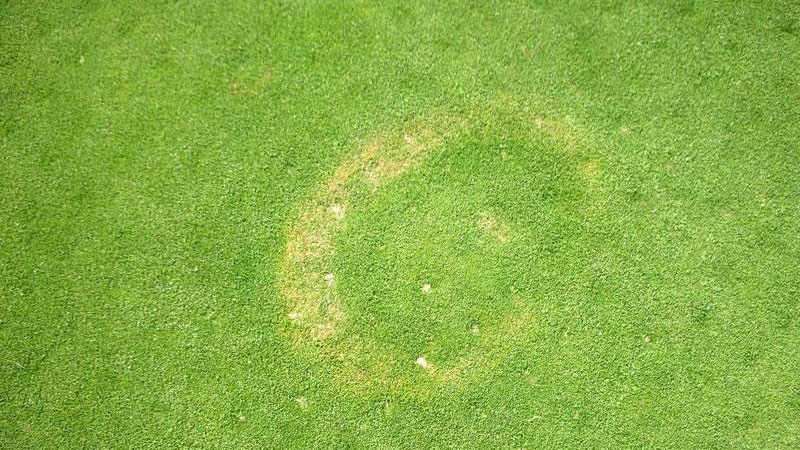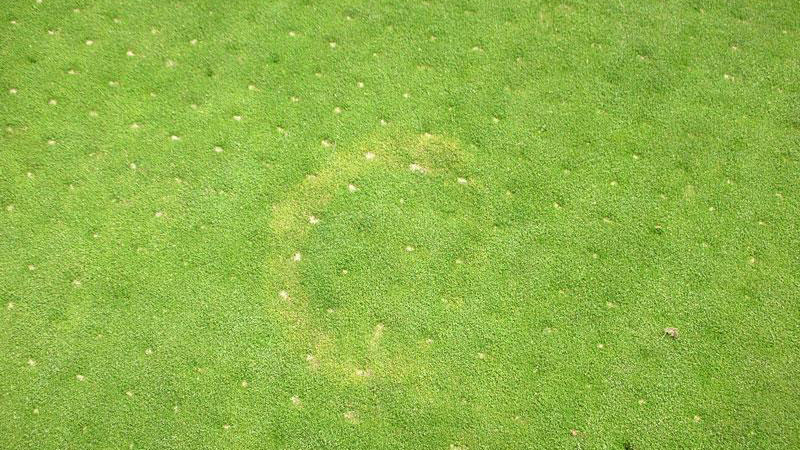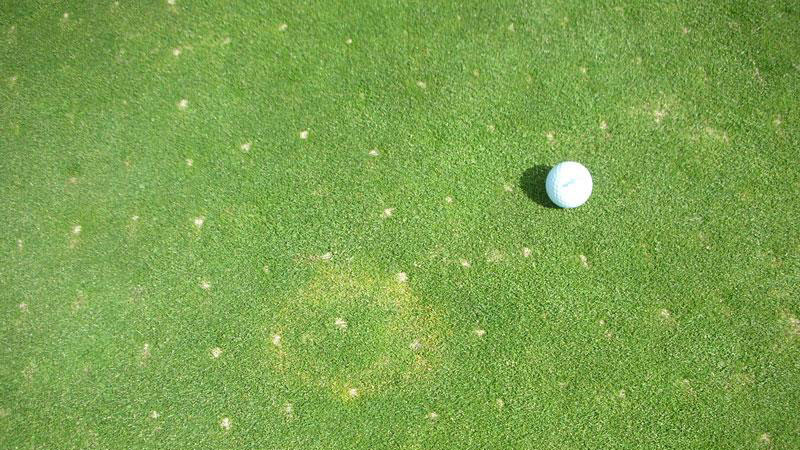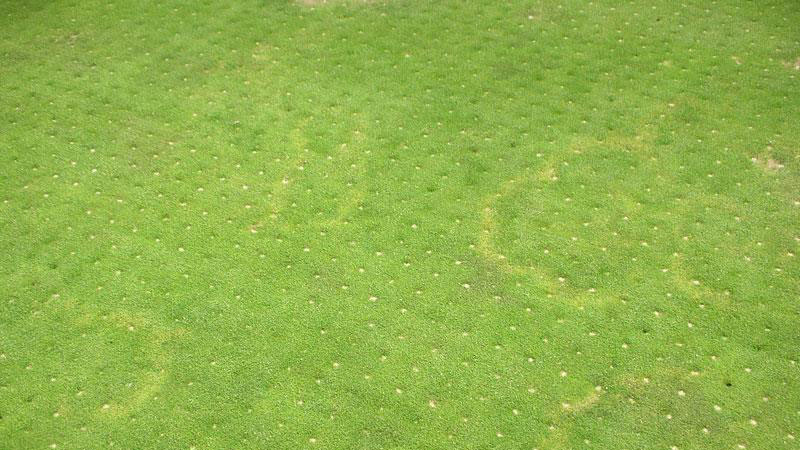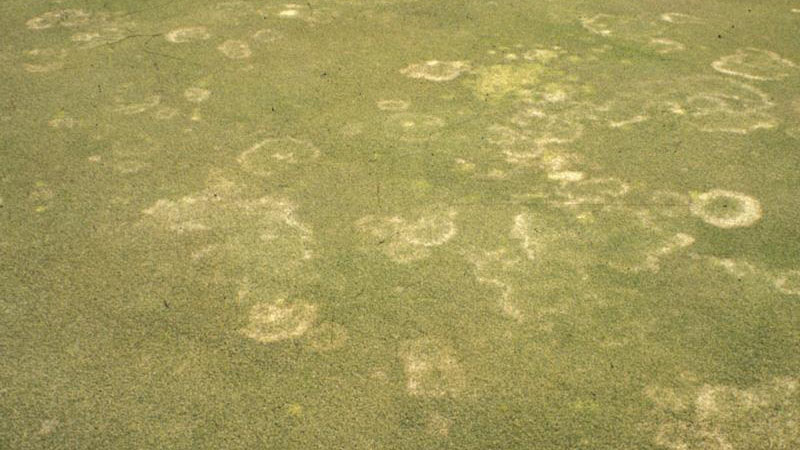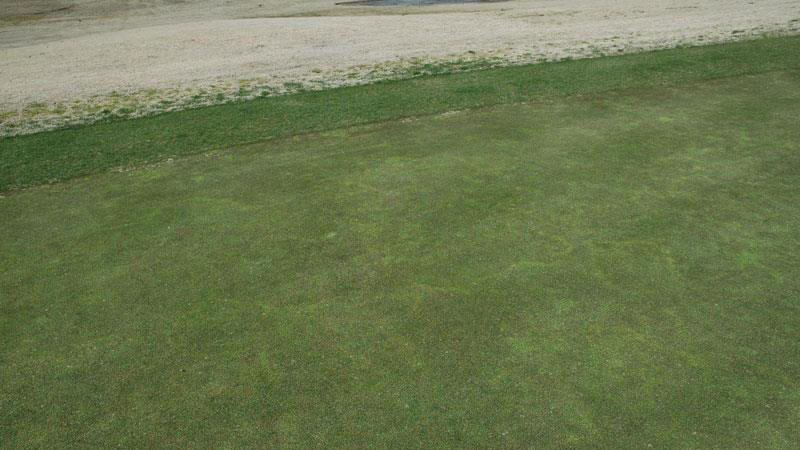Symptoms
Yellow patch is a common disease of cool-season turfgrasses (bentgrasses, bluegrasses, fescues) during the fall, winter, and spring. Symptoms appear as irregular patches or rings up to 3 feet in diameter that are yellow or white in color. Multiple rings or patches may coalesce to form large, irregularly-shaped areas. Individual plants exhibit a yellow dieback of leaves or blighting of entire plants. No distinct lesions are evident on the affected plants. Recovery from yellow patch can be very slow because it occurs at a time of the year when the turf is growing slowly.
Development Factors
Yellow patch develops during extended periods of cool, cloudy, wet weather. The pathogen is most active when temperatures are between 50 and 65°F, but may cause infections under a broader temperature range (45 to 75°F). Excessive nitrogen applications, heavy thatch accumulations, and poor soil drainage also encourage development of this disease.
Cultural Control
Avoid high rates of nitrogen (> 0.25 lb N/1,000 square feet) during the late fall and early spring when yellow patch is most active, and use slow release fertilizers during this time so as to prevent flushes of foliar growth. Ensure adequate surface and subsurface drainage, and aerify and topdress to reduce thatch accumulations. Pruning or removal of trees will increase sunlight penetration and speed recovery from yellow patch if symptoms appear.
Chemical Control
Yellow patch is best controlled on a preventative basis where it is a persistent problem. Curative applications will prevent further spread, but recovery will be slow if weather conditions are not conducive to turfgrass growth. In North Carolina and other areas of the southern United States, yellow patch can be controlled curatively as fluctuating temperatures in fall, winter, and spring lead to intermittent periods of disease development and turfgrass growth.
* Products marked with an asterisk are not labeled for home lawn use.
| Fungicide and Formulation1 | Amount of Formulation2 | Application Interval (Days)3 | Efficacy Rating | Resistance Risk | FRAC Code4 |
| azoxystrobin (Heritage) WG TL G |
0.4 2 2 to 4 lbs |
28 28 14 to 28 |
++++ | Low | 11 |
| azoxystrobin + acibenzolar-S-methyl (Heritage Action)* | 0.2 to 0.4 | 14 to 28 | ++++ | Low | 11/P01 |
| azoxystrobin + chlorothalonil (Renown)* | 2.5 to 4.5 | 14 to 28 | ++++ | Low | 11/M5 |
| azoxystrobin + difenoconazole (Briskway)* | 0.5 to 1.2 | 14 to 28 | ++++ | Low | 11/3 |
| azoxystrobin + propiconazole (Headway) ME G |
3 2 to 4 lbs |
28 14 to 28 |
++++ | Low | 11/3 |
| azoxystrobin + tebuconazole (Strobe T)* | 1.5 | 14 to 21 | ++++ | Low | 11/3 |
|
benzovindiflupyr + difenoconazole (Ascernity)* |
1.0 | 14 to 21 | ++++ | Low | 7/3 |
| chlorothalonil + fluoxastrobin (Fame C)* | 3 to 5.9 | 14 to 28 | ++++ | Low | M5/11 |
| chlorothalonil + propiconazole + fludioxonil (Instrata)* | 8 to 11 | late fall | +++ | Low | M5/3/12 |
| chlorothalonil + thiophanate-methyl (Spectro)* | 3 to 5.76 | 14 to 21 | ++ | Low | M5/1 |
|
cyazofamid + azoxystrobin (Union) |
5.75 | 28 | ++++ | Low | 21/11 |
| fludioxonil (Medallion) | 0.5 | 1 application | ++ | Low | 12 |
| fluoxastrobin (Fame) SC G |
0.36 2.3 to 4.6 lbs |
28 14 to 28 |
++++ | Low | 11 |
| fluoxastrobin + tebuconazole (Fame T)* | 0.45 to 0.9 | 21 to 28 | ++++ | Low | 11/3 |
| flutolanil (Prostar) (Pedigree) |
1.5 2.2 |
21 to 28 21 to 28 |
+++ +++ |
Low Low |
7 |
| metconazole (Tourney) | 0.37 to 0.44 | late fall | +++ | Low | 3 |
| propiconazole (Banner MAXX) | 3 to 4 | late fall | ++ | Low | 3 |
|
pydiflumetofen + azoxystrobin + propiconazole (Posterity XT)* |
3 | 28 | ++++ | Low | 7/11/3 |
| tebuconazole (Mirage)* | 1 to 2 | 21 to 28 | ++ | Low | 3 |
| triticonazole (Triton FLO) (Trinity) |
0.55 to 1.1 1 to 2 |
21 to 28 21 to 28 |
+++ | Low | 3 |
| triticonazole + chlorothalonil (Reserve)* | 3.2 to 5.4 | 21 to 28 | +++ | Low | 3/M5 |
| 1 Other trade names with the same active ingredients are labeled for use on turfgrasses and can be used according to label directions. 2 Units are oz, fl oz, or lb depending on formulation. Apply fungicides in 2 to 5 gallons of water per 1,000 square feet according to label directions. Use lower rates for preventive and higher rates for curative applications. 3 Use shorter intervals when conditions are very favorable for disease. 4 Fungicide Resistance Action Committe code. Products with same code have the same mode of action and are in the same chemical class. * Products marked with an asterisk are not labeled for home lawn use. |
|||||
| Efficacy Rating ++++ = excellent control when conditions are highly favorable for disease development +++ = good control when disease pressure is high, excellent control when disease pressure is moderate ++ = good control when disease pressure is moderate, excellent control when disease pressure is low + = good control when disease pressure is low ? = not rated due to insufficient data |
|||||
| Resistance Risk Low = Rotate to different chemical class after 3-4 applications; tank mixing not necessary Medium = Rotate to different chemical class after 1-2 applications; tank-mixing with low or medium risk product recommended High = Rotate to different chemical class after EVERY application; tank-mix with low or medium risk product for EVERY application ? = not rated due to insufficient data |
|||||
Species Data
- HOST SPECIES
- creeping bentgrass, annual bluegrass, Kentucky bluegrass, tall fescue
- MONTHS WITH SYMPTOMS
- October to March
- STAND SYMPTOMS
- FOLIAR SYMPTOMS LOCATION / SHAPE
- dieback from leaf tip, blighting of entire leaves, leaf lesions
- FOLIAR SYMPTOMS COLOR
- yellow
- ROOT / CROWN SYMPTOMS
- none
- FUNGAL SIGNS
- none
Publication date: Nov. 14, 2017
Revised: Dec. 16, 2019
Recommendations for the use of agricultural chemicals are included in this publication as a convenience to the reader. The use of brand names and any mention or listing of commercial products or services in this publication does not imply endorsement by NC State University or N.C. A&T State University nor discrimination against similar products or services not mentioned. Individuals who use agricultural chemicals are responsible for ensuring that the intended use complies with current regulations and conforms to the product label. Be sure to obtain current information about usage regulations and examine a current product label before applying any chemical. For assistance, contact your local N.C. Cooperative Extension county center.
N.C. Cooperative Extension prohibits discrimination and harassment regardless of age, color, disability, family and marital status, gender identity, national origin, political beliefs, race, religion, sex (including pregnancy), sexual orientation and veteran status.

